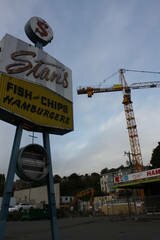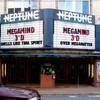 "Another Damn Condo" courtesy of Flickr's Great_Beyond
"Another Damn Condo" courtesy of Flickr's Great_Beyond
(For prescient, you can't beat Clark Humphrey, who wrote this 2002 story on Belltown's future--a year after The McGuire opened: "In 1999, city officials estimated that 150 to 200 recently built condo units had some form of water damage, needing a total of over $100 million in repairs. Some of these buildings will undoubtedly fall into serious disrepair before their occupants have paid off their mortgages.")
I wanted to know more about the city's role in assuring condo owners of quality construction of their homes--stepping back from this particular extreme instance to discuss the inspection process, and what level of responsibility the city takes for the number of water-damaged condos out there. DPD Deputy Director Alan Justad took the time to write back.
My first question was inspired by a Seattle Times story on the McGuire, in which I learned the city "does not inspect structural components of large buildings directly, but instead relies on a private report from a third-party inspection firm selected by the contractor."
What's the thinking behind allowing contractors to pick their own inspectors?
I think that was from a misstatement by me. The building code specifies that the owner selects the third-party inspector, not the builder. The demands of special inspections is such that it is not practical for the city to staff that work. Larger jobs can require as many of three special inspectors at the site on some days; sometimes an inspector needs to be there all day. We’ve had years where there were over 1000 projects needing special inspections. The standard throughout the country is to use private sector inspectors for this specialized work that requires ongoing oversight at the job site.
Is the use of a rain screen system solely at the discretion of the architect/contractor? If so, has the city considered implementing guidelines to promote (if not require) use of a system?
Yes, this is a design decision for the applicant and their design team. We’re not planning to require it—there are other systems that work.*...
Bing's Streetside view captures the scaffolded look of The McGuire
Yesterday, the news broke that a 25-story high-rise in Belltown, The McGuire, would be torn down just nine years after construction, due to "defects." The $31-million apartment tower, at 210 Wall Street, had been clad in scaffolding for months, as the owners tried to deal with cracking and spalling of the concrete exterior, due to problems with reinforcement placement in the building’s frame.
Further investigation revealed that post-tensioned slabs--widely used in high-rises to help support and strengthen the concrete, and allow for thinner floors--contained cables that were corroding. (After it opened, The McGuire fairly quickly had troubles with water entering the building's envelope, and then the wrong paint and grout had been used to protect the cables from water, as well.) The City of Seattle Department of Planning and Development told the owners to repair it or vacate by the end of 2010.
Given the costs of repair, the Carpenters Union Local 131 and MEPT, the Multi-Employer Property Trust, gave hundreds of residents notice to vacate. (The McGuire's original developers were the Carpenters Union Local 131 and Harbor Properties.) Ronald Holden, Belltown's eyes and ears, reports on his blog Cornichon that residents are being offered substantial incentives to quit the building by May 15.
Legal advisers Kennedy Associates said the owners were suing the general contractor and architects. Emporis.com and the city's permits confirm that the general contractor on the project was the national firm McCarthy Building Companies, Inc., one of the top ten commercial builders in the U.S. Here is their differentiator:
Because we are true builders, owners get more and better options. Faster and safer execution. And a clear cost/benefit solution that yields the best final cost, every time.
Structural engineers were ABKJ, who also worked on Harbor Steps and Belltown's Arbor Place. Architecture firm Hewitt has a long list of Seattle projects, from Harbor Steps and Belltown's The Klee lofts and suites, to the Capitol Hill light rail station and University Village. Most recently, they are working on Belltown's Third & Cedar project, a 17-story tower with about 200 units, funded by HB Capital....
Most Viewed Stories
- Hie Yourself to Beecher's for Free Mac & Cheese ('til Closing Tonight)
- Mental Illness Drove Capitol Hill's Hatchet Killer
- Tens of Thousands in State May Lose Federal Unemployment Benefits
- McDonald's Adds Insult to Injury with Local Billboard Campaign
- Iron Chefs Galore at CIA's Worlds of Flavor Conference







Most Recent Comments